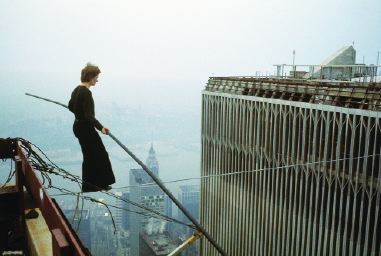Man on Wire

On August 7, 1974, around 7:15 A.M., just as New York City was waking up and trudging off to work, a 24-year-old Frenchman was taking a walk on a metal cable that was strung between the twin towers of the still-uncompleted World Trade Center. He walked for 45 minutes, occasionally stopping to squat and sit but always remaining at arm’s length from nervous police officers who were trying to coax him inside. Down below, New York was in the midst of a social and economic depression; Richard Nixon would resign the following day. But up on the wire euphoria reigned as Philippe Petit completed the task he claims he was destined to do ever since he dreamed, as a child, of walking between two large towers.
Directed by British documentarian James Marsh, Man on Wire tells the mesmerizing story of the quixotic Petit and his fateful stroll. Though it is based in part on Petit’s memoir of the event, To Reach the Clouds, the film ups the ante by calling in the other principal players in the story—not only those who helped Petit plot and pull off the dangerous ploy, but also those who got cold feet and pulled out at the last minute.
The film, which won a pair of awards at this year’s Sundance Film Festival, is a masterful combination of character and plot. Though Petit is clearly the star of the show as the whimsical artist whose ambitions have always been larger than life, the documentary is more than just a paean to his courage and vision. Rather, it morphs into a cinematic bow to the sort of grandiose dreams that used to be more commonplace in our culture. It is especially refreshing to revisit a time when stunts or performances were appreciated for their bravado and audacity alone, a genuine happening, to use 1960s lingo, rather than part of a “very special television event” sponsored by a sports drink company.
Structurally, the film introduces us to the high-energy but complicated Petit and chronicles his previous high-wire stunts, including unannounced walks at Notre Dame Cathedral and the Sydney Opera House. We get to know his motley cohorts, including one who was completely stoned on the day of the big walk; his best friend and coconspirator Jean-Louis, whom he ultimately disappoints; and his loyal girlfriend, Annie, whom he ultimately betrays. We witness how the plot was hatched, the plan developed and the obstacles overcome, thanks in large part to some very dumb luck.
Man on Wire is pieced together with a skillful mix of talking heads, re-creations and old film footage, including footage of rehearsals in a grassy field outside Paris that captures the joy and childlike wonder of “walking the wire.”
The film is a crime caper of sorts, as we follow the tense hours and minutes leading up to the dramatic moment when he steps out onto the wire (a moment celebrated with Erik Satie music in the film). Even though we know that he will not fall, we can’t help but wonder if there will be some sort of Icarus moment.
Instead of being a character study, a plot-driven drama or a thematic treatise, Man on Wire most resembles a fairy tale, a “Once upon a time there was a boy who wanted to walk between two large towers.” Adding to the mythology of the tale is the fiery fate of the twin towers 27 years later. To his credit, director Marsh never mentions the disaster, and he wisely resists the temptation to draw comparisons between the two “terrorist” acts. But a single still photo with an airplane in the sky just behind Petit foreshadows the destruction to come.
But that is now and this was then, the film seems to be saying. Man on Wire is best appreciated as a celebration of humankind’s imagination and desire to soar, a reminder that we are still “such stuff that dreams are made on.”





